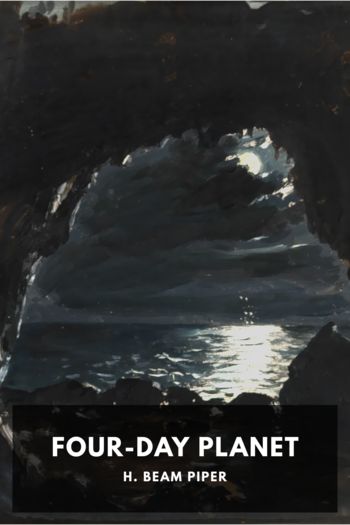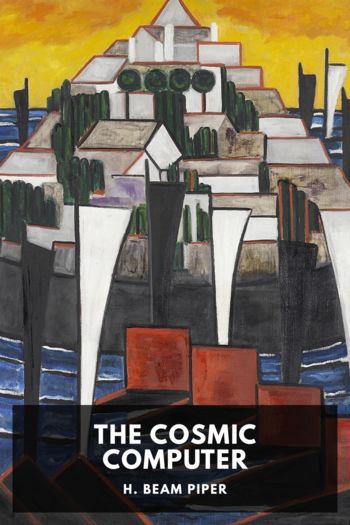Four-Day Planet H. Beam Piper (best books to read for success .txt) 📖

- Author: H. Beam Piper
Book online «Four-Day Planet H. Beam Piper (best books to read for success .txt) 📖». Author H. Beam Piper
First, he jacked the price of wax up, which made everybody but the wax buyers happy. Everybody who wasn’t already in the Coop hurried up and joined. Then he negotiated an exclusive contract with Kapstaad Chemical Products, Ltd., in South Africa, by which they agreed to take the entire output for the Coop. That ended competitive wax buying, and when there was nobody to buy the wax but Kapstaad, you had to sell it through the Cooperative or you didn’t sell it at all. After that, the price started going down. The Cooperative, for which read Steve Ravick, had a sales representative on Terra, Leo Belsher. He wrote all the contracts, collected all the money, and split with Ravick. What was going on was pretty generally understood, even if it couldn’t be proven, but what could anybody do about it?
Maybe somebody would try to do something about it at the meeting this evening. I would be there to cover it. I was beginning to wish I owned a bulletproof vest.
Bish and Tom were exchanging views on the subject, some of them almost printable. I had my eyes to my binoculars, watching the tugs go up to meet the Peenemünde.
“What we need for Ravick, Hallstock and Belsher,” Tom was saying, “is about four fathoms of harpoon line apiece, and something to haul up to.”
That kind of talk would have shocked Dad. He is very strong for law and order, even when there is no order and the law itself is illegal. I’d always thought there was a lot of merit in what Tom was suggesting. Bish Ware seemed to have his doubts, though.
“Mmm, no; there ought to be some better way of doing it than that.”
“Can you think of one?” Tom challenged.
I didn’t hear Bish’s reply. By that time, the tugs were almost to the ship. I grabbed up the telephoto camera and aimed it. It has its own power unit, and transmits directly. In theory, I could tune it to the telecast station and put what I was getting right on the air, and what I was doing was transmitting to the Times, to be recorded and ’cast later. Because it’s not a hundred percent reliable, though, it makes its own audiovisual record, so if any of what I was sending didn’t get through, it could be spliced in after I got back.
I got some footage of the tugs grappling the ship, which was now completely weightless, and pulling her down. Through the finder, I could see that she had her landing legs extended; she looked like a big overfed spider being hauled in by a couple of gnats. I kept the butt of the camera to my shoulder, and whenever anything interesting happened, I’d squeeze the trigger. The first time I ever used a real submachine gun had been to kill a blue slasher that had gotten into one of the ship pools at the waterfront. I used three one-second bursts, and threw bits of slasher all over the place, and everybody wondered how I’d gotten the practice.
A couple more boats, pushers, went up to help hold the ship against the wind, and by that time she was down to a thousand feet, which was half her diameter. I switched from the shoulder-stock telephoto to the big tripod job, because this was the best part of it. The ship was weightless, of course, but she had mass and an awful lot of it. If anybody goofed getting her down, she’d take the side of the landing pit out, and about ten percent of the population of Fenris, including the ace reporter for the Times, along with it.
At the same time, some workmen and a couple of spaceport cops had appeared, taken out a section of railing and put in a gate. The Peenemünde settled down, turned slowly to get her port in line with the gate, and lurched off contragravity and began running out a bridge to the promenade. I got some shots of that, and then began packing my stuff back in the hamper.
“You going aboard?” Tom asked. “Can I come along? I can carry some of your stuff and let on I’m your helper.”
Glory be, I thought; I finally got that apprentice.
“Why, sure,” I said. “You tow the hamper; I’ll carry this.” I got out what looked like a big camera case and slung it over my shoulder. “But you’ll have to take me out on the Javelin, sometime, and let me shoot a monster.”
He said it was a deal, and we shook on it. Then I had another idea.
“Bish, suppose you come with us, too,” I said. “After all, Tom and I are just a couple of kids. If you’re with us, it’ll look a lot more big-paperish.”
That didn’t seem to please Tom too much. Bish shook his head, though, and Tom brightened.
“I’m dreadfully sorry, Walt,” Bish said. “But I’m going aboard, myself, to see a friend who is en route through to Odin. A Dr. Watson; I have not seen him for years.”
I’d caught that name, too, when we’d gotten the passenger list. Dr. John Watson. Now, I know that all sorts of people call themselves Doctor, and Watson and John aren’t too improbable a combination, but I’d read Sherlock Holmes long ago, and the name had caught my attention. And this was the first, to my knowledge, that Bish Ware had ever admitted to any off-planet connections.
We started over to the gate. Hallstock and Ravick were ahead of us. So was Sigurd Ngozori, the president of the Fidelity & Trust, carrying a heavy briefcase and accompanied by a character with a submachine gun, and Adolf Lautier and Professor Hartzenbosch. There were a couple of spaceport cops at the gate, in olive-green uniforms that looked





Comments (0)